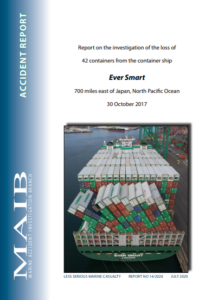The UK MAIB issued an investigation report on the loss of containers from the ship Ever Smart in October 2017. The investigation highlighted a combination of factors resulted in a loss of integrity for the whole deck cargo bay; in particular, the containers were not stowed or secured in accordance with the cargo securing manual and the container lashings might not have been secured correctly.
The incident
On 30 October 2017, the UK registered container ship Ever Smart suffered a container stow collapse while on passage between Taipei, Taiwan and Los Angeles, USA.
The master had changed the ship’s passage plan to avoid severe weather caused by a developing depression east of Japan.
The ship continued in heavy seas; rolling and pitching heavily with frequent bow flare slamming.
Once the weather had abated, the crew discovered that the container stacks on the aft most bay had collapsed and toppled to port.
Of the 151 containers in the stow, 42 were lost overboard and 34 were damaged. Superficial damage was caused to the ship.
Findings
- The container stow collapse on board Ever Smart was caused by a combination of factors; in particular, container weight distribution, container lashing arrangements and the ship’s motion.
- The collapse was discovered during a deck lashings’ inspection at 1648 on 30 October, but it most likely occurred shortly before 0240 that morning.
- The stow collapse to port was probably initiated by a lashing system or structural container failure in bay 70’s starboard outer stack.
- The container stowage plan developed by the shore planners did not comply with the instructions and guidance contained in the ship’s cargo securing manual. Of note: the container weight distribution was not in accordance with the stack weight tables; hi-cube containers were loaded eight high in the outer stacks of the stow; and the ship’s GM exceeded the recommended full load GM.
- The weights of the containers’ allocated slots in bay 70 did not match or resemble the weight distribution patterns provided in the CSM; the weights in the upper tiers exceeded the values given in the stack weight tables and those in the lower tiers were much reduced. This would have caused the stacks’ centre of gravity to move upwards, and the acceleration forces acting on the lashings and containers at the bottom of the stack to increase.
- The stowing of hi-cube containers eight high in the outer stacks raised the height of the stacks and therefore further increased the acceleration forces acting on the containers and their lashings. It also increased the windage area of the outer stacks.
- Ever Smart’s GM exceeded that used in the CSM to calculate stack weight limits, weight distribution and lashing patterns for the bays aft of the accommodation block when loaded to their maximum container carrying capacity.
- Bay 70 was not lashed in accordance with the instructions and guidance provided in the CSM and by the lashing system manufacturer.
- Many lashing rod turnbuckle lock nuts had not been applied and, as a result, there was a high likelihood that some of bay 70’s lashings would loosen.
- The ship’s loading computer was not fully utilised, and warnings that the permissible load limits could be exceeded were not acknowledged or were ignored.
- The master’s course and speed alterations during the voyage to avoid the worst of the weather and reduce hull vibrations were effective. The roll amplitude remained well below the calculated maximum and the frequency of stern shaking was reduced.
- It is likely that the accident occurred at the time the hull vibrations and frequency of stern shaking were at their worst. The vibration was probably the result of whipping forces transferred through the hull as the ship’s bow slammed into the sea.
- The gale force wind was acting directly on the starboard outer stack, and its effect would have been significantly amplified due to the increased height and lack of the additional wind lashings prescribed in the CSM.
Recommendations
UK MAIB made recommendations to Evergreen Marine Corp. (Taiwan) Ltd to improve standards of stowage plans produced ashore, knowledge of the dangers of bow flare slamming and lashing gear maintenance management.
Explore more herebelow:
































































